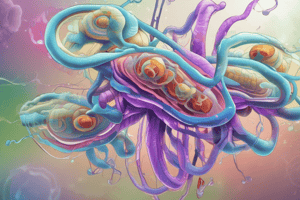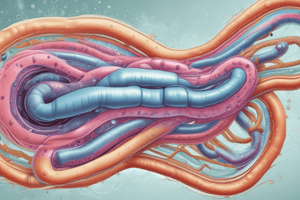Podcast
Questions and Answers
Which of the following are classifications of Vibrio? (Select all that apply)
Which of the following are classifications of Vibrio? (Select all that apply)
- Biophysical Vibrios
- Chemical Vibrios
- Halophilic Vibrios (correct)
- Non Halophilic Vibrios (correct)
What is the morphology of V. cholerae?
What is the morphology of V. cholerae?
Gram negative, curved/comma shaped rod, non sporing, non capsulated, motile
Which media is considered alkaline for culturing V. cholerae?
Which media is considered alkaline for culturing V. cholerae?
- Peptone water (correct)
- Nutrient agar
- MacConkeys
- Blood agar
V. cholerae is resistant to common disinfectants.
V. cholerae is resistant to common disinfectants.
What components make up the antigenic structure of V. cholerae?
What components make up the antigenic structure of V. cholerae?
What type of toxin is produced by V. cholerae?
What type of toxin is produced by V. cholerae?
What is the mechanism of action of the cholera enterotoxin?
What is the mechanism of action of the cholera enterotoxin?
El Tor Vibrio is a biotype of V. cholerae.
El Tor Vibrio is a biotype of V. cholerae.
Which test is NOT positive for El Tor Vibrio?
Which test is NOT positive for El Tor Vibrio?
Flashcards are hidden until you start studying
Study Notes
Classification of Vibrio
- Non Halophilic Vibrios can grow without salt, including V. Cholerae (O1 classical and El Tor biotype) and Non O1 V. Cholerae.
- Halophilic Vibrios, which require salt for growth, include V. Parahaemolyticus, V. Alginolyticus, and V. Vulnificus.
Morphology of V. Cholerae
- Gram-negative bacterium with a curved or comma-shaped rod structure.
- Non-sporing and non-capsulated.
- Exhibits motility characterized by darting movement.
Culture Conditions
- Grows well in alkaline media; ordinary media includes nutrient agar, MacConkey's agar, blood agar, peptone water, and gelatin stab.
- Special media for transport and enrichment includes VR and Cory Blair media, as well as APW and Monsurs Taurocholate tellurite peptone water.
- Plating media consists of Bile salt agar, GTTA, and TCBS.
Biochemical Reactions
- Exhibits a cholera red reaction.
- Shows a negative result in the methyl red test.
Resistance
- Susceptible to heat, drying, and common disinfectants.
- Can survive in water for extended periods, up to several months.
Antigenic Structure
- Composed of somatic O antigen.
- Contains flagellar H antigen, which is common across all strains of V. Cholerae.
Toxins
- Produces a heat-stable endotoxin.
- Excretes an exotoxin known as cholera toxin, which is an enterotoxin.
Enterotoxin Characteristics
- Cholera toxin is heat-labile and consists of one A subunit and five B subunits.
- Mechanism of action involves the A1 fragment stimulating adenyl cyclase activity, leading to increased cAMP production which causes hypersecretion of water and electrolytes in the intestine and inhibition of Na/Cl reabsorption, resulting in rice water stools diarrhea.
El Tor Vibrio
- Isolated from Haj pilgrims, representing a biotype of V. Cholerae.
- Positive for the chick red cell agglutination test.
- Sensitive to polymyxin B.
- Sensitive to Cholera Phage IV (Mukherjee phage IV).
- Positive in the modified CAMP test.
Studying That Suits You
Use AI to generate personalized quizzes and flashcards to suit your learning preferences.




